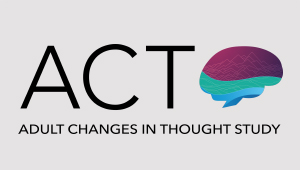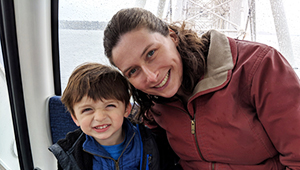HIV/AIDS research advances through Pamela Shaw's work

KPWHRI Senior Biostatistics Investigator Pamela Shaw, at a beach near Riga, Latvia
Shaw's project to reduce the impact of errors in data was just honored with an NIH MERIT award
Ahead of World AIDS Day, we're recognizing the work of Senior Biostatistics Investigator Pamela Shaw, PhD, MS. Shaw's outstanding research in HIV and AIDS was recognized with a rare honor: a National Institutes of Health (NIH) MERIT award.
Shaw's $4.2 million, 5-year NIH grant on statistical methods and designs for studies of HIV/AIDS, with Bryan Shepherd, PhD, at Vanderbilt University, could receive 5 extra years of funding through MERIT (Method to Extend Research in Time). The award is based on the researchers' "superior competence and productivity" and confidence in their future results.
Shaw is delighted about the award. It ensures stable, long-term funding for the project, because renewing support requires only a brief report evaluated directly by NIH instead of a full, externally reviewed proposal. She said, "It'll save us at least 6 months, so we can just keep doing the research!"
You have expertise in aging, immunology, clinical trials, nutritional and physical activity epidemiology, and more. Why does your MERIT-award project focus on HIV/AIDS?
People with HIV can live a long time with anti-HIV therapy. Extended use of these medications sometimes creates risks, though — for example, for liver fibrosis. We also need to consider the medications’ impact on frailty, with people living longer.
But HIV/AIDS can be hard to study. It occurs in difficult-to-reach populations. Clinical trials are expensive and not always an appropriate or feasible study design.
Many HIV/AIDS studies use existing data, often from readily available electronic health records, or EHRs, which have massive amounts of observational data on people living with HIV. EHRs are imperfect for research, though.
EHR data are not collected for the explicit purpose of supporting research, but by doctors, as part of patient care. They might not record lifestyle factors or other information a study is interested in, like physical activity. Also, for research, EHR data are generally retrieved by automated computer algorithms, because of the large scale of this resource. This can miss important information in the records and be misguided by information that isn't relevant. These data errors, if not adjusted for statistically, can introduce bias into study results.
Our work elevates research with EHR data by developing study designs and analytical methods that identify and adjust for the potential impact of error-prone data. We work to improve the precision and accuracy of study results. More precise answers to research questions lead to better clinical guidance and decision-making, improving care for people living with HIV by accurately predicting their risks and responses to therapy.
How does your work lead to better clinical research?
The gold standard for using EHRs in research is having humans extract the data through medical chart review. That takes time and it's expensive.
We're developing resources such as free software for researchers to find which patients' records are most informative for the health outcomes and populations of their study. We'll offer statistical methods for adjusting analyses relying on EHR data — by incorporating gold standard information from chart review of a small number of records or information from studies that regularly collect information on a sample of patients — to get more accurate results.
The goal is to give researchers a recipe to follow with guidance on how to augment HIV/AIDS studies that use observational data with validation from gold standard data to ensure the best possible results for clinical decision-making. Our methods work for other studies, too. We recently used them to study how excess weight gain during pregnancy affects early childhood risk of asthma and obesity.
Since graduate school, I've worked on error-prone data and developing statistical methods to make research with the data more accurate. The HIV/AIDS work is a long-time partnership with Bryan Shepherd at Vanderbilt University, a leader in biostatistics in HIV/AIDS. We're using the NIH-supported International epidemiology Databases to Evaluate AID (IeDEA), which have decades of data on more than 2.2 million people in 44 countries.
Your recent career includes 7 years at NIH and 8 years at University of Pennsylvania. What brings you to Seattle?
I have degrees from the University of Washington and colleagues and family in the area. I've always maintained relationships here.
What I love about research is the global community. I gain new partnerships without letting go of the old ones.
What makes KPWHRI the best place for you to do your research?
It’s the synergy between my research and people at the institute mining EHR data for important studies, like on suicide risk prediction, mental health therapy, and better health care delivery.
The ACT Study — the Adult Changes in Thought Study — was a big draw because it's a long-term observational study of Kaiser Permanente Washington members, with EHR data and chart review and prospectively collected data. ACT gets gold standard data directly from participant visits every 2 years. Many participants donate their brains after they die, so we get definitive diagnoses for dementia, including Alzheimer’s.
ACT lets us study how to best use EHR and other types of study data whose availability varies among participants. For example, only some participants have had MRIs or have detailed physical activity data. We can develop methods to adjust for different amounts of research data, so study results represent all ACT participants and Kaiser Permanente members.
I came to KPWHRI just as the new ACT funding started. A major goal is making the study more representative of traditionally marginalized racial and ethnic groups, and I was able to help design ways to do that. ACT is already seeing results: Before, new participants were 80% to 90% white. Now, new recruitment is about 50% from historically marginalized groups, so we are moving toward a much more diverse cohort.
What do you enjoy doing when you're not at work?
Knitting sweaters and hats and things for the little ones I know. I'm an avid cycler, so that's another draw for the Pacific Northwest. The East Coast is freezing in winter and hot as heck in summer, and I don't mind the rain, so I'm happy to be back to Seattle for cycling and hiking.
I also love birding. I have about 10 birdfeeders. It's like a farm — every day I go out and fill all the birdfeeders and watch the birds that come visit throughout the day. Birding is a great way to stay connected to all the amazing nature around us in Seattle.
By Chris Tachibana
Learn About the ACT Study

Understanding brain aging
For over 30 years, the Adult Changes in Thought (ACT) Study has been advancing our understanding of cognition, aging, and better ways to delay and prevent Alzheimer’s disease and related dementias.
Healthy findings blog

What motivates Yates Coley’s work on prediction models?
Their work contributes to improved quality of care and better understanding of patients’ needs.
healthy findings blog

How is biostatistician Susan Shortreed improving care?
A love of problem-solving, math, and health science drive Dr. Shortreed’s work for better mental health treatment.


